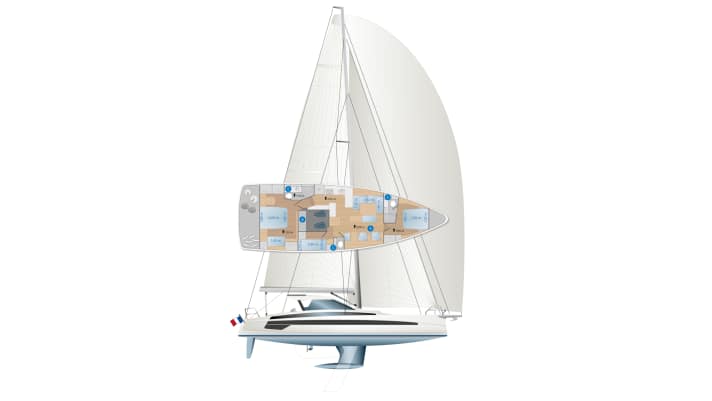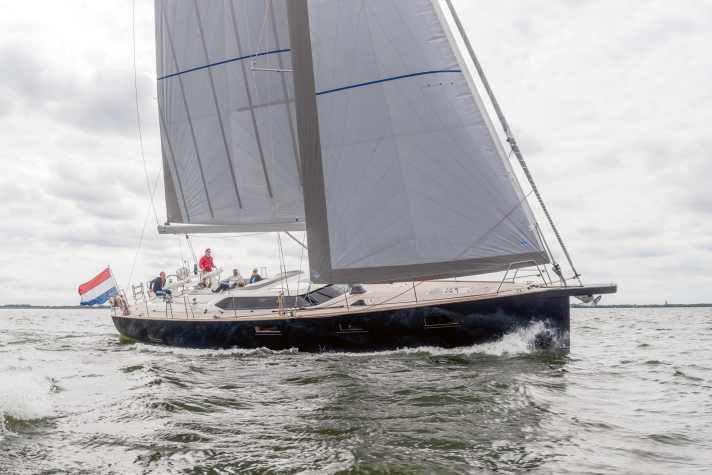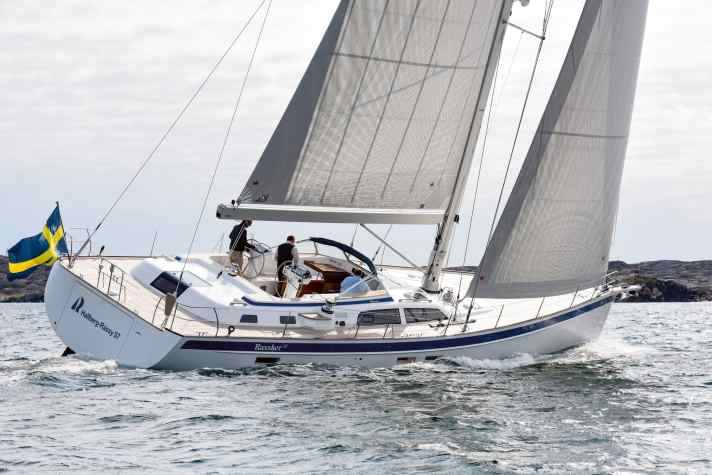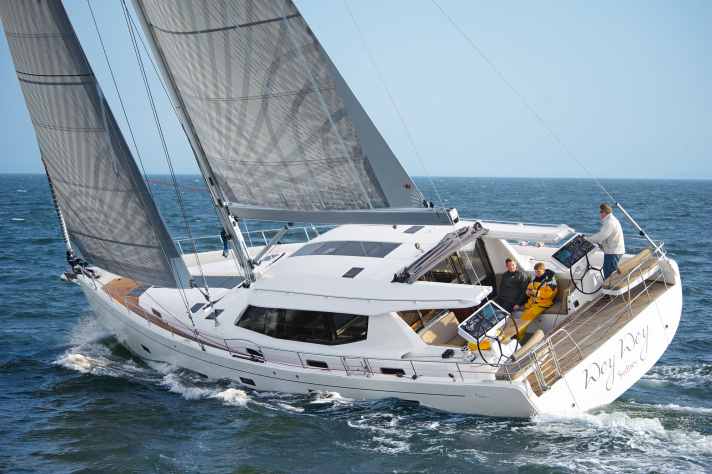





"Have you seen it yet?" At Boot in Düsseldorf, one yacht in particular was a talking point among visitors. With its dominant shapes and unique design, the new Wauquiez 55 was able to set many exciting and unique accents, making it the number one topic of conversation.
For three years now, the Wauquiez Yachts shipyard has been part of the French Exel Industries group - a family-run industrial group specialising in agricultural machinery and garden technology. Now the Ballu family, who own the company, want to build up another mainstay with their involvement in the nautical sector. This intention stems not only from economic interest, but also from personal passion: sailing has a long tradition in the Ballu family.
The Exel Group now also includes the well-known western French brand Tofinou with its elegant daysailers and the motorboat manufacturer Rhéa Marine.
More from the shipyard group:
Since the takeover, a fresh breeze has been blowing through the traditional shipyard in Neuville-en-Ferrain on the French-Belgian border - where Henry Wauquiez laid the foundations for his visionary cruising and blue water yachts over 60 years ago. What's more, the new owners and managing directors are focussing on a radical new start with a comprehensive restructuring.
A new start while maintaining the brand tradition
The new Wauquiez 55, with its striking, forward-looking concept, is now making its debut. A second, similarly positioned model of unknown size is already being planned. At the same time, however, the young shipyard management has apparently completely discontinued production of all previous models from the long-standing Pilot-Saloon and Centurion programmes. This means that Wauquiez Yachts is daring to make the ultimate new start.
Despite its fresh development, the Wauquiez 55 remains true to the traditional brand values. These include a consistent focus on owner use, a high degree of customisation, first-class build and finishing quality, above-average standard equipment and the uncompromising conception as a blue water yacht. However, the design and construction have changed. Studio Marc Lombard is responsible for the extraordinary appearance of the Wauquiez 55. The striking and independent design stands out from the market, in particular due to the strongly indented running decks, which run high above the deck with a pronounced negative step. Other special features include the stepped aft deck and the striking doghouse above the low-set centre cockpit.
Of course, the concept is not entirely new or exclusive. A comparative look at the competition reveals certain parallels, for example with the Amel 60, which is significantly larger. Similarities can be found, for example, in the side-mounted steering position or in the form of the deck structure, which simulates a teak overlay but is an integral part of the laminate superstructure.
Ideal test conditions lead to considerable sailing fun
The test with the new 55 takes place off Port Camargue in the south of France. The conditions couldn't be better: Between 12 and 15 knots of wind, plus a short, steep wave about 1.5 metres high. However, the Wauquiez 55 is unable to fully utilise its strengths in strong winds. The genoa on the test boat doesn't yet fit on the short hove-to points and the hydraulic downhaul from the optional furling boom bumps against the doghouse when the sail is hauled tight. Because the sails cannot be fully tightened, the construction number one cannot run higher than 50 degrees to the wind. However, 7.3 knots are still possible with the sheets forced to be shrouded.
The Wauquiez is able to demonstrate its full potential when sailing with a gennaker. In the gusts, the yacht, which is comparatively light with a total weight of 20 tonnes, still accelerates noticeably and quickly reaches double-digit values on the log. The record on the test day: 11.4 knots - a remarkable figure for a boat of this type. The test boat is equipped with the optional swing keel, which enables a draught variation of 1.60 to 4.20 metres. The L-shaped fixed keel with a very high ballast ratio of 47 per cent is standard.
Measured values of the Wauquiez 55





Steering on the Wauquiez, on the other hand, is no revelation. Due to the long distances from the steering position in the centre cockpit to the quadrants of the double rudder blades in the stern, the shipyard uses double Bowden cables instead of cables. Although this is a technically flawless and functionally very reliable solution, it also lacks a good feel for the boat. The steering feels spongy and indirect, which does not make it easy for the helmsman to steer the boat optimally in the wind.
In addition, the seating position at the helm is not very comfortable when heeling. On long journeys, you would therefore prefer to use the autopilot and make yourself comfortable on one of the nice long thwarts in the cockpit.
Double motorisation
Sailing a large boat like the Wauquiez 55 means a lot of pressure and a lot of power. And you need to know how to handle it correctly and safely. Wauquiez wants to simplify these issues as much as possible and offers optional electric drives for all functions for setting and trimming the sails. This reduces the effort involved in manoeuvres to simply pressing the many switches and buttons at the helm. However, because the two large and powerful winches on the companionway are very close together, care must be taken when working with the halyards and sheets, especially with the support of the powerful electric drives.
A special feature of the new concept from Wauquiez is the dual motorisation. As standard, two Volvo Penta built-in diesels are installed, each with an output of 50 hp; alternatively, two more powerful units with an output of 75 hp are also available. Because the drives are installed exactly in the centre of the boat and at a lateral distance of 1.20 metres, it is possible to turn the boat on the plate using only the engines. During the test in the harbour, this works impressively well even in crosswinds and with the swing keel raised. If you know how to use it, you don't need a bow or stern thruster to dock without any problems.
According to the shipyard, the two engines together should consume less fuel than a large engine with more displacement and power. And they should also run more quietly. However, this cannot be confirmed in the test. At cruising speed (80 per cent of maximum speed) and 7.8 knots, a noise level of 75 decibels was measured in the aft cabin. That is comparatively loud.
Living studio below deck
In terms of the quality of the interior fittings, the Frenchwoman need not fear comparison even with Scandinavian standards. The workmanship is flawless and harmonious down to the smallest detail. The very robust joinery work, which Wauquiez produces by hand and with a high proportion of solid wood, is particularly pleasing.
The highlight below deck is undoubtedly the huge aft cabin for the owners with separate access from the aft deck. However, the term "cabin" is almost an understatement. Rather, it is a small living studio with a king-size double bed, en-suite bathroom, seating area and a desk. The many windows in the hull and at the stepped stern provide stunning views. So much transparency is new even in the large yacht class.
The impeccably and unusually elaborately installed on-board technology is also a delight. The water supply and electrical systems as well as the air conditioning systems are not only easily accessible, but are also controlled via bus systems that provide information on the operating status via an app.
Prices of the Wauquiez 55
Price categorisation is difficult because the technology and equipment standards within the upper classes are often not of the same quality.
- Base price ex shipyard: 1.940.330 €
- Standard equipment included: Engine (2 x), sheets, railing, navigation lights, battery, compass, cushions, galley/cooker, bilge pump, toilet, sailcloth, anchor with chain, mooring lines, fire extinguisher, electric cooler, holding tank with suction system
- For an extra charge: Sails (main and genoa) € 67,050, fenders € 570, antifouling € 10,255, clear sailing handover € 26,190
- Price ready to sail: 2.044.395 €
- Guarantee/against osmosis: 2/2 years
- Surcharge for comfort equipment: Line adjustable anchor points incl.; Traveller with line guide incl.; Electric anchor windlass incl.; Tube kicker incl.; Backstay tensioner incl.; Spring cleats incl.; Sprayhood incl.; Teak not available in cockpit; VHF radio Nav. Pack; log and echo sounder Nav. Pack; Anemometer Nav. Pack; Garmin Nav. Pack € 32,295; Autopilot € 10,865; Battery charger incl.; Electrical package incl.; Shore power with RCD incl.; 230-volt socket (one) incl.; 12-volt socket in the Navi incl.; Heating € 20,690; Pressurised water system incl.; Hot water boiler incl.; Shower WC room incl.; Cockpit shower incl.
- Comfort price: 2,108,245 € (Included in the price: Bowsprit with anchor bracket, cockpit table, bathing platform)
As of 2025, as the prices shown are defined, you will find here!
With a base price of just under two million euros gross without sails, the Wauquiez must be categorised in the high-price segment and will have to stand up to comparison with ships from Hallberg-Rassy or Contest.
Conclusion
The Wauquiez 55 is a conceptually and visually unusual ship that is not aimed at the masses. But this is precisely what makes the luxury cruiser particularly appealing.
YACHT review of the Wauquiez 55
A ship like no other. The Wauquiez 55 from France not only stands out from the competition visually, but also conceptually. Despite a few teething troubles, the prototype also impresses under sail during the test.
Design and concept
Attractive, striking design
Consistent alignment
Push-button sailing possible
Wider than the competition
Sailing performance and trim
Good trimming facilities
Remarkable potential
Little steering feel on the wheel
Uncomfortable control position
Living and finishing quality
Solid woodwork
Beautiful, bright interior design
Separate access aft
Bunk in foredeck too short
Equipment and technology
Double motorisation
Good standard equipment
Swivelling keel as an option
High noise level aft
The Wauquiez 55 in detail

Technical data of the Wauquiez 55
- Design engineer: Marc Lombard Yacht Design
- CE design category: A
- Torso length: 16,40 m
- Total length: 17,60 m
- Waterline length: 15,20 m
- Width: 5,25 m
- Draught fixed keel (hours): 2,50 m
- Draught Swivelling keel: 1,60-4,20 m
- Mast height above WL: 23,60 m
- Theor. torso speed: 9.5 kn
- Weight: 20,0 t
- Ballast/proportion (hours): 9,45 t/47 %
- Mainsail: 86,0 m²
- Furling genoa (106 %): 78,0 m²
- Stagfock: 44,0 m²
- machine (Volvo P.): 2 x 50 hp
- Fuel tank (stainless steel): 610 l
- Fresh water tanks (stainless steel): 750 l
- Holding tank (PVC): 3 x 50 litres
Hull and deck construction
GRP sandwich constructions with PET foam core. Laminated with vacuum infusion.
Features of the Wauquiez 55
- Doubly motorised: From the shipyard, the boat is equipped with two built-in engines (Volvo Penta D2-50) with saildrive and 3-blade folding propellers. Two engines with 75 hp each can also be installed as an option. The shipyard is also working on options for two electric drives.
- Free choice of rig: The 2-saling aluminium rig from Sparcraft is the standard. A furling mast is possible or, as on the test boat, a carbon fibre mast with furling boom. The considerable surcharge for this is 275,000 euros.
- Sail for an extra charge: The sail inventory is not part of the basic equipment. The single set of sails (main and genoa) costs around 67,000 euros extra.
- Batteries: The 24V power supply is provided by four AGM batteries, each with a capacity of 140 Ah. Lithium or gel batteries are optionally available.
Shipyard and distribution
Wauquiez Yachts, 59535 Neuville-en-Ferrain (FRA); www.wauquiez.com
Upscale luxury in a large format - the competition
Contest 55 CS

Attractive blue water cruiser from Holland with a tidy appearance and amazingly agile sailing characteristics in the YACHT test. Exciting deck layout with a recessed cockpit for guests. You can read the test here.
Hallberg-Rassy 57

The yachts from Ellös are well known for their good sailing characteristics and the high standard of fittings and equipment. The 57 is of course no exception. Read the test here.
Jeanneau Yachts 55

Exciting owner's boat with an unusual but also very innovative layout. The special features are the covered cockpit and the huge aft deck. More about the Jeanneau Yachts 55.
Moody 54 DS

Safe and first-class built ocean-going yacht from Greifswald. The extremely exciting monomaran concept combines the advantages of monohulls and catamarans. Numerous variants. Test in YACHT 22/2014.

